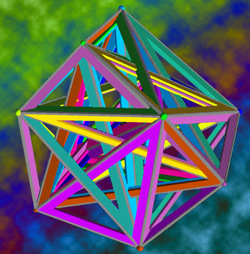Jaron Lanier
Discover Sun, 08 Apr 2007 07:21 UTC
A lifelong obsession leads to the mysterious hedecatope - a seemingly impossible geometric form that, in its own small way, links together the whole universe.

|
| ©Computer model courtesy of Carlo Sequin
|
In this 3-D slice of the four-dimensional
hendecatope, colored beams represent the
edges of triangles; some triangles are left
out for simplicity.
|
A serene orb of ice is set against the gentle pastel clouds of giant Saturn. Rhea transits the face of the gas giant, whose darkened rings and their planet-hugging shadows appear near upper right.

|
| ©NASA/JPL/Space Science Institute
|
The microeconomic law of diminishing marginal utility states that while accumulating a good - pretzels, pencils, nickels, whatever - each successive unit of that good will be less satisfying to acquire than the one before it. Finding a shiny quarter on the street is a real thrill. But, if you are carrying around a bag of coins, acquiring another one does not seem nearly as exciting. In fact, would you even bother to pick it up?
That hesitation is what researchers at the University of Cambridge in England were banking on when they designed a study to see if the haves catch on more slowly than the have-nots when it comes to reward-based learning. Reporting in the current issue of Neuron, the scientists reveal that when a small sum of money is on the line, poorer people learn quickly how to maximize their profits, leaving their wealthier counterparts in the dust.
Lisa Zyga
PhysorgFri, 06 Apr 2007 18:04 UTC
Economists who yearn for the redistribution of wealth in an ideal society are up against history. According to a recent study, the uneven distribution of wealth in a society appears to be a universal law that holds true for economies in many different societies, from ancient Egypt to modern Japan and the U.S. This distribution may reflect a simple natural law analogous to a 100-year-old theory describing the distribution of energy in a gas.
Scientists Arnab Chatterjee and Bikas Chakrabarti from the Saha Institute of Nuclear Physics, along with Sitabhra Sinha of the Institute of Mathematical Sciences, both in India, have analyzed a variety models explaining different sets of data, and found striking similarities. The results show that the poorer majority of the population follows one distribution, while a small proportion of the wealthiest people veers off in a tail following a power-law distribution, in essence reflecting how "the rich get richer."
The studies included large sets of data from sources such as income tax returns and net values of assets in societies including Japan, the U.S., the UK, India, and nineteenth century Europe. The data, taken from a large number of recent publications by several groups, represented a variety of different economies and stages of development. Generally, the lower 90% of the population (in terms of income) followed a log-normal distribution, characterized by an initial rapid rise in population followed by a rapid fall as income increased.
Robert Roy Britt
Space.comFri, 06 Apr 2007 17:50 UTC
Scientists have solved a decades-long mystery of a red glow that permeates our Milky Way Galaxy and other galaxies.
The red glow is most prominent in a strange, dying star called the Red Rectangle, named for the bizarre structure that surrounds it.
The red light, astronomers now say, radiates from invisibly small clusters of dust that are now believed to glow because of newly described molecular forces that oppose each other on very small scales.
The glow, called the Extended Red Emission (conveniently ERE for short) has been known but inexplicable for more than 30 years. Researchers suspected carbon-rich molecules called polycyclic aromatic hydrocarbons (PAHs) were the culprit. These clusters of molecules form a structure that looks like chicken wire; they are measured on a scale of billionths of a meter, far too small to see.
New solar cells developed by Massey University don't need direct sunlight to operate and use a patented range of dyes that can be impregnated in roofs, window glass and eventually even clothing to produce power.
LIDIA WASOWICZ
UPIThu, 27 Mar 2003 09:23 UTC
New government laboratory test results are fueling a controversial contention that a giant natural nuclear reactor at the center of the Earth powers the planet's life-protecting magnetic field -- but it might be running out of gas, scientists told United Press International.
Lisa Zyga
PhysorgThu, 05 Apr 2007 09:20 UTC
What are the odds that poker can be explained by statistical physics, much the same as a variety of other complex systems? They're pretty good, according to physicist Clément Sire of Université of Toulouse and CNRS in France, who demonstrates in a recent paper that many of the statistical properties of poker tournaments are universal. Sire's model makes connections between poker and evolution, extreme value statistics and the physical model of persistence.
"In this Letter, we study a very human and futile activity: poker tournaments," Sire writes in his paper, to be published in an APS Physical Review journal. His model quantifies the evolution of Texas hold 'em tournaments, based on aspects such as the distribution of chips, the number of surviving players over time, etc. Overall, his results closely mirror those observed in real-life online tournaments.
Geophysicists at the University of Rochester announce in today's issue of Nature that the Earth's magnetic field was nearly as strong 3.2 billion years ago as it is today.
The findings, which are contrary to previous studies, suggest that even in its earliest stages the Earth was already well protected from the solar wind, which can strip away a planet's atmosphere and bathe its surface in lethal radiation.
"The intensity of the ancient magnetic field was very similar to today's intensity," says John Tarduno, professor of geophysics in the Department of Earth and Environmental Sciences at the University of Rochester. "These values suggest the field was surprisingly strong and robust. It's interesting because it could mean the Earth already had a solid iron inner core 3.2 billion years ago, which is at the very limit of what theoretical models of the Earth's formation could predict."
It has been a mystery for astronomers how certain dying stars have their colossal quantities of material blown out into the universe and shrink into objects called "white dwarves". This is the basis of a ground-breaking new theory by astrophysicists Anja C. Andersen from the Dark Cosmology Centre at the University of Copenhagen and Susanne Hцfner of the University of Uppsala.
Earth and the other planets in our solar system are built up of elements which have been produced in earlier generations of stars. Deep in the stars' very hot core, the elements are created out of hydrogen, and when the stars explode and die, the elements are shot out into the universe as huge clouds of gas and dust. Gradually, all that dust aggregates, eventually forming new stars and planets.
Pitch-black dust clouds
Stars smaller than our sun and up to eight times as large die by first swelling up to being a red giant, and then shrinking to a white dwarf. There are two types of red giants, one contains lots of carbon and the the other a lot of oxygen. When the carbon-rich stars die, large clouds of carbon particles such as soot and graphite are produced. Soot and graphite are pitch-black, so when the rays from the dying star hit the soot particles they stop the light and are pushed out into space, where they are seen as gigantic dust clouds. This is a 20 year old theory which fits both the observations and the model calculations.

